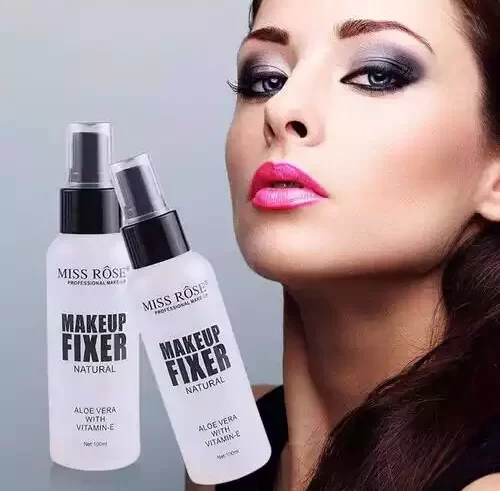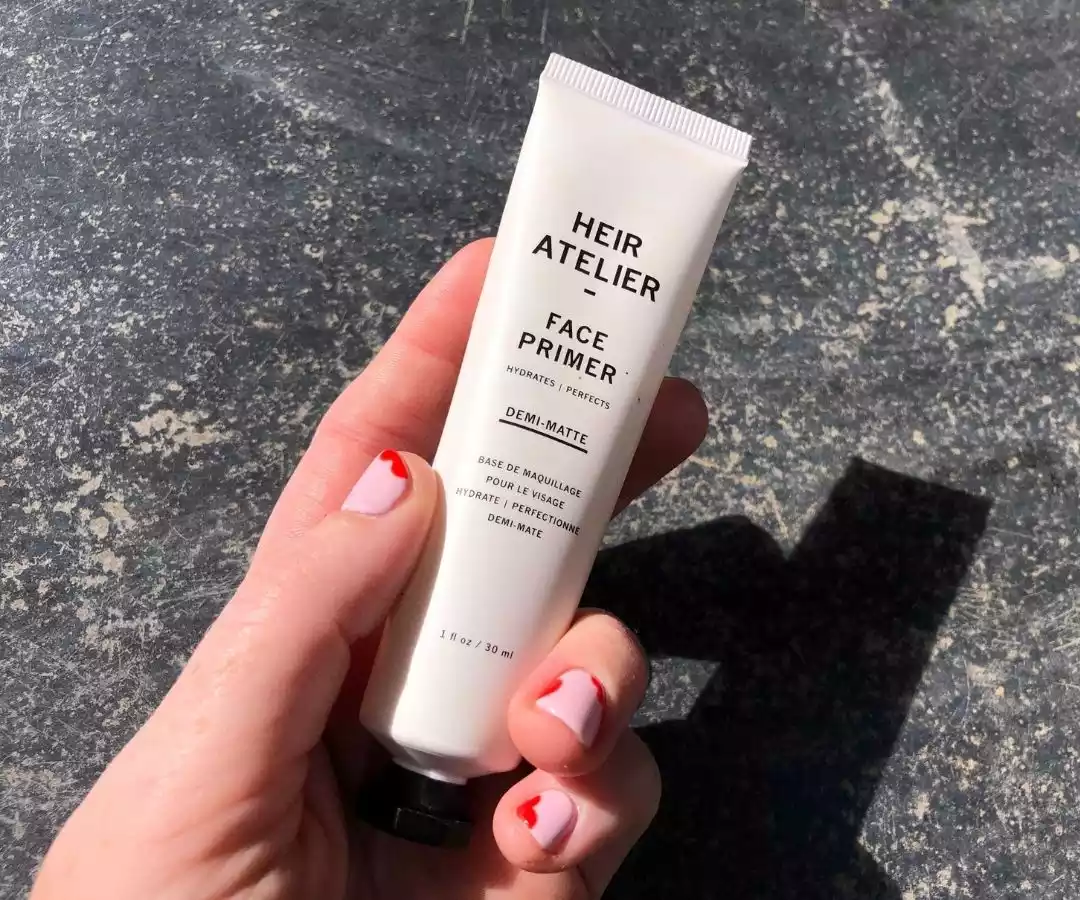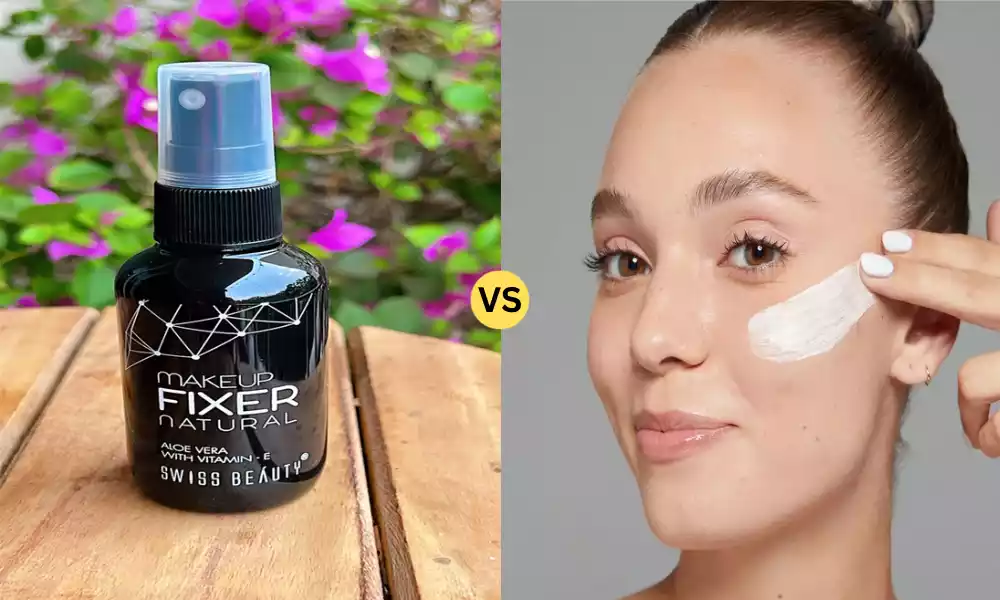Introduction of Makeup Fixer and Primer
Makeup, to many, is a form of art and self-expression. The proper execution of makeup involves more than just choosing the right color palette or blending technique. At the base of every makeup masterpiece is the preparation and preservation of the canvas—your skin. Two products often brought up in this context are makeup primers and fixers. Despite their importance, there’s a cloud of confusion surrounding these products. In this article, we aim to demystify the difference between a makeup fixer and primer, helping you achieve that flawless finish.
Definition of Makeup Fixer
A Makeup Fixer, also known as a setting spray or finishing spray, is a cosmetic solution specially formulated to keep applied makeup intact and vibrant for extended periods. Housed typically in a spray bottle, its liquid composition is misted onto the face after completing the makeup routine, creating a protective barrier against external elements like sweat, humidity, and incidental contact.

This barrier prevents makeup from smudging, fading, or settling into fine lines, ensuring a fresh and pristine look for hours. Depending on its formulation, a makeup fixer can also provide additional benefits, such as imparting a matte or dewy finish, or hydrating the skin. In essence, a makeup fixer acts as the final sealant in a makeup regimen, much like a topcoat protects a manicure.
Definition of Primer
A Primer is a cosmetic or skincare product applied before makeup to prepare and enhance the skin’s surface, ensuring a smoother makeup application and improved longevity. Primers create an even base, helping to minimize the appearance of pores, fine lines, and imperfections. They also improve the adherence of foundation, eyeshadow, or other makeup products, preventing them from creasing, fading, or becoming patchy.

Available in various forms like creams, gels, and powders, primers may offer additional benefits, such as moisturizing, oil-controlling, or sun protection. Essentially, a primer acts as an intermediary layer, bridging the gap between skincare and makeup, optimizing the look and wear of cosmetic products on the skin.
Importance of the Difference Between Makeup Fixer and Primer
Understanding the distinction between makeup fixers and primers is crucial for multiple reasons:
- Foundation for Makeup: Think of makeup application akin to painting on a canvas. A primer ensures that the canvas, in this case, the skin, is prepared and smooth. This step ensures that makeup applies evenly and adheres properly. Without a primer, makeup might appear patchy or accentuate pores and fine lines.
- Preservation of Makeup: On the other hand, a fixer acts like a protective top coat. After you’ve applied your makeup, a fixer ensures its longevity. It sets the makeup in place, reducing the chances of it smudging, fading, or settling into lines throughout the day.
- Optimized Performance: Using both products optimizes the performance of your makeup. A primer gives you the perfect base, and the fixer ensures the makeup remains flawless for extended periods.
- Economic Efficiency: Investing in makeup products can be expensive. By using a primer, you ensure that you use less foundation or eyeshadow because it adheres better and shows up more vibrantly. With a fixer, you don’t need as many touch-ups during the day, thus prolonging the life of your makeup products.
- Skin Protection: Some primers also offer additional benefits such as SPF or moisturizing properties, providing an added layer of protection to the skin. Fixers can also offer hydration, ensuring that the makeup doesn’t dehydrate the skin or lead to a cakey finish.
- Customization for Skin Types: Understanding the difference allows users to select products tailored to their specific skin needs. For instance, matte primers and fixers are available for oily skin types, while hydrating ones cater to dry skin.
While primers and fixers may seem like additional steps in a makeup routine, their roles are pivotal. The former sets the stage, ensuring that the makeup looks its best upon application, while the latter preserves the artwork, ensuring it looks fresh for hours. Knowing the distinction ensures that makeup enthusiasts get the most out of their makeup routine, both in terms of appearance and longevity.
Comparison Table of Makeup Fixer and Primer
Here’s a simplified comparison table for Makeup Fixer and Primer:
| Aspect | Makeup Fixer | Primer |
|---|---|---|
| Usage | After makeup application | Before makeup application |
| Purpose | – Sets makeup
– Enhances makeup longevity |
– Prepares the skin
– Enhances makeup adherence |
| Ingredients | Often contains:
– Alcohol – Hydrating agents |
Often contains:
– Silicones – Vitamins |
| Texture/Form | – Liquid mist | – Cream
– Gel |
| Effects | – Prevents makeup from smudging or fading | – Smooths out skin texture
– Fills in pores and lines |
| When to Reapply | Can be reapplied during the day for refreshment | Rarely, if ever |
This table provides a general overview, and individual products may vary. Always check the product’s label or consult with a beauty specialist for specific details.
Benefits of Makeup Fixer and Primer
Here’s a concise breakdown of the benefits of makeup fixers and primers:
Makeup Primer:
- Smooth Base: Provides an even canvas, minimizing pores and fine lines.
- Enhanced Adhesion: Improves makeup adherence, preventing patchiness.
- Economical: Less makeup product needed due to better adherence.
- Skin Protection: Many offer SPF or moisturizing benefits.
- Tailored Solutions: Varieties available for specific skin needs (e.g., matte for oily skin).
Makeup Fixer:
- Longevity: Sets makeup in place, reducing smudging and fading.
- Fresh Finish: Prevents makeup from settling into lines or appearing cakey.
- Reduced Touch-ups: Makeup lasts longer, needing fewer touch-ups.
- Protection: Some offer hydration or protective barriers against environmental stressors.
- Instant Refresh: Can rejuvenate and freshen up makeup mid-day.
Understanding these benefits allows users to maximize the efficacy of their makeup routines.
Side effects of Makeup Fixer and Primer
Here’s a concise overview of potential side effects associated with makeup fixers and primers:
Makeup Primer:
- Breakouts: Can clog pores, leading to acne in some individuals.
- Allergic Reactions: Some ingredients might cause redness, itching, or rashes.
- Dryness: Matte-finish primers can dehydrate the skin.
- Silicone Concerns: Some believe silicones can trap debris in pores, though research on this is inconclusive.
Makeup Fixer:
- Dryness: Alcohol-based fixers can dehydrate the skin.
- Irritation: Ingredients, especially in scented versions, can irritate sensitive skin.
- Sticky Residue: Some fixers can leave a tacky finish.
- Breathing Hazard: Aerosol fixers should not be inhaled; always use in well-ventilated areas.
- Allergic Reactions: Like primers, certain ingredients might lead to redness, itching, or rashes.
It’s always recommended to perform a patch test when trying a new product and to be aware of any known skin sensitivities.
Choosing the Right Product for Your Skin Type
Here’s a concise guide for selecting the right primer and fixer based on your skin type:
Dry Skin:
- Primer: Look for moisturizing and hydrating properties.
- Recommendation: Too Faced Hangover Replenishing Face Primer.
- Fixer: Opt for hydrating, dewy finishes without alcohol.
- Recommendation: MAC Prep + Prime Fix+.
Oily Skin:
- Primer: Seek mattifying and oil-controlling features.
- Recommendation: Benefit Cosmetics The POREfessional Face Primer.
- Fixer: Go for mattifying, long-lasting sprays.
- Recommendation: NYX Professional Makeup Matte Finish Makeup Setting Spray.
Sensitive Skin:
- Primer: Choose fragrance-free, hypoallergenic options.
- Recommendation: First Aid Beauty Hello FAB Coconut Skin Smoothie Priming Moisturizer.
- Fixer: Opt for gentle, fragrance-free sprays.
- Recommendation: Clinique Moisture Surge Face Spray Thirsty Skin Relief.
Mature Skin:
- Primer: Find products that offer a radiant finish and hydration.
- Recommendation: Laura Mercier Foundation Primer – Radiance.
- Fixer: Prioritize fine mist and hydrating features.
- Recommendation: Tarte Cosmetics Stay Spray Setting Spray.
Combination Skin:
- Primer: Use balancing products; might need zone-specific primers.
- Recommendation: Laura Mercier Foundation Primer for varied zones.
- Fixer: Opt for balanced and refreshing sprays.
- Recommendation: Make Up For Ever Mist & Fix Setting Spray.
When trying new products, always consider patch-testing to avoid adverse reactions.
Application Tips for Flawless Finish
- Primer:
- Start with a cleansed and moisturized face.
- Apply a pea-sized amount and spread evenly, focusing on areas with visible pores or fine lines.
- Allow it to set for a minute before applying foundation.
- Fixer:
- Hold the bottle at arm’s length.
- Close your eyes and mist your face in a T and X pattern to cover all areas.
- Allow it to dry naturally.
Mistakes to Avoid
- Overusing Product: Too much primer can make makeup slide off. Overdoing fixer can result in a cakey look.
- Not Allowing Time: Let your primer settle before applying makeup and let your fixer dry naturally for best results.
- Choosing Wrong Formulas: Always consider your skin type.
Product Recommendations
- Primers:
- Dry Skin: Too Faced Hangover Replenishing Face Primer
- Oily Skin: Benefit Cosmetics The POREfessional Face Primer
- Sensitive Skin: First Aid Beauty Hello FAB Coconut Skin Smoothie Priming Moisturizer
- Mature Skin: Smashbox Photo Finish Foundation Primer
- Fixers:
- Dry Skin: Urban Decay All Nighter Long-Lasting Makeup Setting Spray
- Oily Skin: NYX Professional Makeup Matte Finish Makeup Setting Spray
- Sensitive Skin: MAC Prep + Prime Fix+
- Mature Skin: Tarte Cosmetics Stay Spray Setting Spray
Conclusion
To achieve a flawless makeup look that stands the test of time, understanding and using both primers and fixers is crucial. While they may seem similar in their promise of longevity, their purposes, ingredients, and times of application vary greatly. With the right knowledge and products suited for your skin type, makeup mishaps can be a thing of the past. Remember, a masterpiece requires both preparation and preservation. The same goes for your makeup.





























